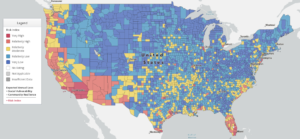As a real estate investor, it is crucial to understand the concept of comparable properties or “comps”. Comparable properties are a vital tool that can help you determine the value of a property you are interested in buying or selling. In this article, we will explore the process of identifying comparable residential properties, including what makes a property comparable, where to find comps, and how to use them to make informed real estate investment decisions.
How to Identify Comparable Residential Properties
Understanding Comparable Properties
Comparable properties, or “comps,” are properties that are similar to the one you are interested in buying or selling. These properties should have similar characteristics such as size, location, age, and features.
In other words, a comp is a property that is similar to the one being evaluated in terms of size, location, condition, and features. For example, if a real estate agent is trying to determine the value of a three-bedroom, two-bathroom house in a particular neighborhood, they will look for recent sales of similar homes in the same area.
The goal is to find comps that are as similar as possible to the property being evaluated. This allows the real estate agent or appraiser to make an apples-to-apples comparison between the properties and arrive at a fair market value for the property in question.
Therefore by analyzing these similar properties, you can get a good idea of what your property is worth, and how it compares to others in the area.
Characteristics of Comparable Properties
When looking for comparable properties, you should consider the following characteristics:
Location
Properties in the same neighborhood or even on the same block are more likely to be comparable than those located miles away. Consider factors such as proximity to amenities, transportation, schools, and crime rates.
Size and Layout
The size and layout of a property can also affect its comparability. Look for properties that have a similar number of bedrooms, bathrooms, and square footage.
Lot Size
The lot size is another factor influencing comparability of a property. Look for properties that have a similar lot size.
Age and Condition
Properties that are of a similar age and condition to the property you are interested in can provide valuable information. Look for properties that have been recently renovated or have similar age and maintenance histories.
Features and Amenities
Lastly, consider the features and amenities of the property. Look for properties with similar upgrades, such as hardwood floors or updated kitchens, as well as similar amenities like a pool or garage.
Where to Find Comparable Properties
There are several ways to find comparable properties, including:
Real Estate Websites
Real estate websites like Zillow, Redfin, and Realtor.com provide a wealth of information about properties in a given area, including sale prices, square footage, and number of bedrooms and bathrooms.
Multiple Listing Service (MLS)
The MLS is a database used by real estate agents to list properties for sale. It can be a valuable source for finding comps because it contains detailed information about the properties listed, including their size, location, and features.
Local Real Estate Agents
Real estate agents can be a valuable resource for finding comps. They have access to the Multiple Listing Service (MLS) and other databases, can use their knowledge of the local market and can provide you with information on recently sold properties to help you find properties that are similar to the one you are trying to value.
Public Records
Public records such as tax assessments and property deeds can provide valuable information about the history and value of a property. You can often find this information online or by visiting the local assessor’s office.
Personal Networks
Finally, your personal network can be a valuable resource for finding comparable properties. Ask friends, family, and colleagues if they know of any properties in the area that are similar to the one you are interested in.
How to Use Comparable Properties
Once you have identified several comparable properties, you can use them to determine the value of the property you are interested in. Here are some steps to follow:
Step 1: Identify the key characteristics of the properties you are comparing.
Look for properties that are similar in location, size, age, and condition.
Step 2: Analyze the sale price of the comparable properties.
Look at the sale price of the comparable properties to get an idea of the market value of the property you are interested in.
Step 3: Adjust for differences in the properties.
Adjust the sale price of the comparable properties for any differences in size, condition, or features.
Step 4: Determine the estimated value of the property.
By analyzing the data from the comparable properties, you can estimate the value of the property you are interested in.
Conclusion
identifying comparable residential properties is a critical skill for real estate investors and homebuyers. It involves searching for recently sold and active listings in the same area with similar features and attributes. It is important to consider the condition, location, age, and type of property when identifying comparable properties. Analyzing the data and considering trends in the market is also important when determining the value of a property. With these skills, you can accurately determine the value of a property and make informed decisions in the real estate market. By understanding what makes a property comparable, where to find comps, and how to use them, you can make informed investment decisions and achieve your real estate goals.
FAQs
- How many comparable properties should I look at?
It is recommended to look at at least three to five comparable properties to get a good idea of the market value of the property you are interested in.
- Can I use commercial properties as comparable properties for a residential property?
No, it is not recommended to use commercial properties as comparable properties for a residential property. The characteristics and market values of commercial properties can be significantly different from residential properties.
- Can I use outdated comps to determine the value of a property?
No, it is not recommended to use outdated comps as the real estate market can change quickly. It is important to use the most recent and relevant comps available.
- What should I do if I cannot find any comparable properties in the area?
If you cannot find any comparable properties in the area, you may need to expand your search to nearby neighborhoods or adjust your investment strategy.
- Can I rely solely on comparable properties to determine the value of a property?
No, while comparable properties are an important tool for determining the value of a property, they should not be the only factor considered. Other factors such as market trends, property features, and condition should also be taken into account. It is important to note that comps are just one tool that real estate agents and appraisers use to determine the value of a property. Other factors, such as the current state of the real estate market, the motivation of buyers and sellers, and the property’s unique features, can also impact the final sale price of a property.

